|
|
|
Sort Order |
|
|
|
Items / Page
|
|
|
|
|
|
|
| Srl | Item |
| 1 |
ID:
133405
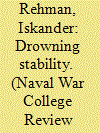

|
|
|
|
|
| Publication |
2012.
|
| Summary/Abstract |
In May 1998, the sun-scorched deserts of the Indian state of Rajasthan shook with a succession of nuclear explosions. Barely two weeks later, in a seemingly tit-for-tat response, Pakistan conducted its own series of detonations, in the remote western hills of Baluchistan. Both nations' previously concealed nuclear capabilities had suddenly burst out into the open, giving a new and terrifying form to the enduring rivalry that had convulsed the subcontinent for decades. Caught off guard, the international community reacted with indignation and dismay. Concerns over nuclear escalation in the event of another Indo-Pakistani conflict refocused Washington's attention on South Asia and triggered the longest sustained level of bilateral Indo-American engagement in history. This had the unexpected benefit of enabling both democracies finally to find common ground, after many years of acrimony, chronic mistrust, and squandered opportunities. Fears of mass terrorism in the wake of 9/11 and subsequent revelations of extensive proliferation emanating from Pakistan added urgency to Western desires to preserve a modicum of crisis stability in South Asia, as well as to prevent any form of escalatory behavior that could spiral into nuclear conflict or further the spread of radioactive material.
|
|
|
|
|
|
|
|
|
|
|
|
|
|
|
|
| 2 |
ID:
104648
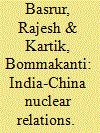

|
|
|
| 3 |
ID:
100371
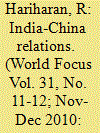

|
|
|
| 4 |
ID:
170574
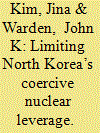

|
|
|
|
|
| Summary/Abstract |
The US and allied goal should be to deter the use of North Korea’s nuclear capabilities rather than to destroy them.
|
|
|
|
|
|
|
|
|
|
|
|
|
|
|
|
| 5 |
ID:
147473


|
|
|
|
|
| Publication |
New Delhi, Oxford University Press, 2016.
|
| Description |
xii, 297p.hbk
|
| Standard Number |
9780199467495
|
|
|
|
|
|
|
|
|
|
|
|
Copies: C:1/I:0,R:0,Q:0
Circulation
| Accession# | Call# | Current Location | Status | Policy | Location |
| 058807 | 363.32/PER 058807 | Main | On Shelf | General | |
|
|
|
|
| 6 |
ID:
108941
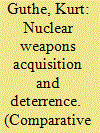

|
|
|
|
|
| Publication |
2011.
|
| Summary/Abstract |
The effects of nuclear weapons acquisition on deterrence will depend on the nature of the state, leadership, or even organization that obtains the weapons; the types of actions to be deterred; the purpose and strategy the weapons serve; the consequences for the military situation between the acquiring state and its adversaries; and the ways in which those adversaries respond to the opposing nuclear threat. The implications of nuclear acquisition for deterrence are likely to change over time as nuclear capabilities move from a nascent state and gain, among other qualities, increased size, longer range, more diversity, better survivability, and greater destructive power. Deterrence is not only a matter of who is being deterred, from what action, by whom, for what reason, by what threats, and in what circumstances, but also when in the extended process of acquiring nuclear weapons capabilities a deterrence challenge occurs.
|
|
|
|
|
|
|
|
|
|
|
|
|
|
|
|
| 7 |
ID:
133599
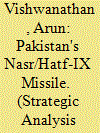

|
|
|
|
|
| Publication |
2014.
|
| Summary/Abstract |
On November 5, 2013 Pakistan conducted its fourth test of the Hatf-IX (Nasr) short range battlefield 'nuclear' missile. To date there have been four flight tests of the missile system. After the first three tests (April 19, 2011, May 29, 2012 and February 11, 2013) Pakistan's Inter Services Public Relations (ISPR) had put out identical press releases.1 These statements claimed that the missile had a range of 60 km and carried 'nuclear warheads (sic) of appropriate yield'. The ISPR statement following the fourth flight test of Nasr, a salvo firing of four missiles, was worded differently and did not repeat the claim that Nasr carried a nuclear warhead. Curiously, it referred to the missile's nuclear capability in a roundabout sort of way. The statement claimed that the missile 'contributes to the full spectrum deterrence against threats in view of evolving scenarios'.2
|
|
|
|
|
|
|
|
|
|
|
|
|
|
|
|
| 8 |
ID:
119255
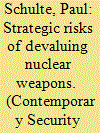

|
|
|
|
|
| Publication |
2013.
|
| Summary/Abstract |
This article surveys the emerging field of meaning represented by 'nuclear devaluation', and the arguments likely to be publicly or privately articulated against it by the elites of nuclear capable states, reaching judgements through the prism of their own strategic cultures in relation to their own national and regime interests. These judgements will be informed by different, often unstated, assumptions about the value of nuclear weapons, particularly the intangible, strategically shaping effects of nuclear capabilities on the peacetime strategic landscape. Political pressures for some form of devaluation will continue, especially within nuclear weapon states concerned to limit further damage to the NPT regime. But devaluation falling short of disarmament will be hard to prove, difficult for other states to rely upon, particularly unappealing to authoritarian regimes, and potentially reversible, while its essential appeal to strategically influential constituencies will be circumscribed by cultural and geostrategic factors. Managing the consequences of unevenly distributed aspirations towards devaluation will nevertheless represent a growing complexity for Western nuclear diplomacy.
|
|
|
|
|
|
|
|
|
|
|
|
|
|
|
|
| 9 |
ID:
137380
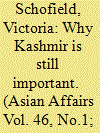

|
|
|
|
|
| Summary/Abstract |
Kashmir, at present, is not being treated as a priority by politicians or policy makers. The author argues that this is a grave mistake. The ground realities which have continued to blight the lives of millions in the region for decades have not been resolved. Not only do they demand resolution, but leave the region fragile and unstable, a danger exacerbated by the nuclear capabilities of India and Pakistan. The domestic narratives within India and Pakistan which lead to heightened hostility have been exacerbated by recent events such as the Mumbai Hotel attacks and cross-border skirmishes. A resolution of Kashmir would reverse these inherent tensions. The unresolved situation also undermines the human rights of the inhabitants of Kashmir. Likewise, it leads to an unconscionable waste of the natural resources of the region, as well as needless restrictions in Indo-Pakistani trade and money being tied up in military conflict. A resolution of the conflict would also have wide-scale benefits in the region, reaching to Afghanistan and China. In conclusion, the author surveys what might be practical ways of resolving the Kashmir problem.
|
|
|
|
|
|
|
|
|
|
|
|
|
|
|
|
|
|
|
|
|